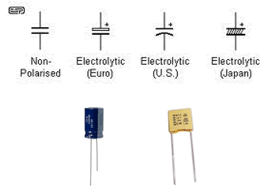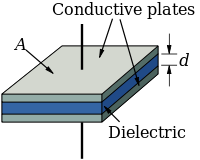Theory
A capacitor consists of two conductors separated by an insulator or dielectric. If a capacitor is joined to a generator, it is instantly charged. The two conductors take on charges of equal absolute value and opposite sign.
The capacitor symbol is as follows:

Outline of symbols and real images
The insulator between the conductor plates can be air, paraffin, mica or glass, etc. Capacitors are used to store charge and also energy.
In experiments, the charge stored in capacitors is checked to ensure that it is proportional to the voltage drop to which its terminals are connected.
The capacitor is charged with charge in its terminal: that is why it provides a voltage drop in its terminal. It is like a battery, but no ReDox process takes place inside it and there is no chemical energy.

Parallel plate Capacitor
A capacitor is an open circuit that stores charge. An example is that a given capacitor discharges. The charges (electrons) in a capacitor cannot jump from one terminal to another: there is a dielectric.
If we
call Q the charge (in absolute value) of one of the capacitor terminal and
Va-Vb the voltage drop between its terminals, then the ratio ![]() is checked to ensure it is constant.
is checked to ensure it is constant.
This ratio receives the name of capacity and is represented by C. It is measured in Farads.
The mathematical calculations of capacitor are outside the scope of this module. The most important thing to know is that the capacitor is sensitive to alternating current to the type of signal and to its frequency. If we imagine that the electrical current is a flow of electrons and the resistance is a tap, then the capacitor is a water tank.